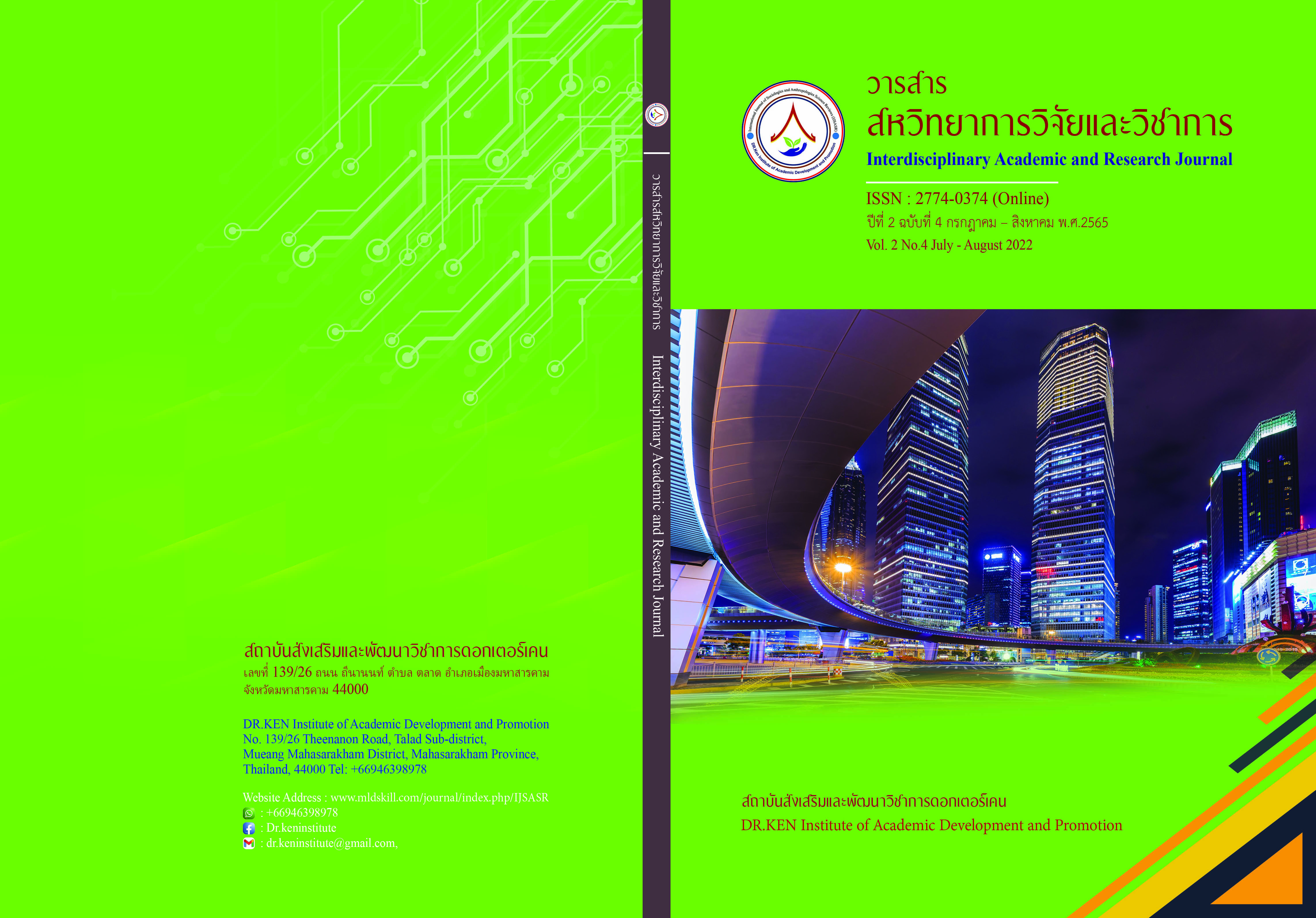The Guidelines of Community Potential Development through Sisaket’s Digital Community Center
DOI:
https://doi.org/10.14456/iarj.2022.51Keywords:
Development; , Community Potential;, Digital Community CenterAbstract
Thailand continues to face challenges in technological development, which has established a digital community center to promote and improve the quality of life of people in the community to be equal and reduce social inequality. The community is therefore an important learning center due to the changing lifestyle of Thailand in the digital era. Therefore, this research aimed to study (1) The Guidelines for developing community potential through Sisaket’s Digital Community Center, and (2) the Comparison of community capacity development through the Digital Community Centre based on personal attributes. The methodology of this research is questionnaires that collected data from 398 service users. The statistic used in the analysis was mean, and standard deviation. Comparative analysis was performed using a t-test and F-test (One Way ANOVA).
The result showed that Digital Infrastructure Factor organization administration personnel competency community involvement education, learning, information social, cultural aspects, economic aspects, and income promotion at a high level. The result of this research showed that age, occupation, and level of community potential development through Sisaket’s Digital Community Center were different by gender and education level. Monthly income differs, and levels of community potential development through Sisaket’s Digital Community Center are not different.
In addition, the results found that the Community Digital Center still lacks public relations in various activities. The personnel in charge of the center are insufficient, thus requiring personnel in the replacement site. The digital center’s location is also located in a place where government offices are intermingled, making accessibility inconvenient and lack of network partners to work together. However, the management also sees that the community digital center is a center that will develop digital abilities for the community to use in their daily lives and can be used in their careers to generate income for families and communities in the future.
References
กนิษฐิกา ศอกกลาง. (2558). การมีส่วนร่วมของชุมชนในการพัฒนาแหล่งท่องเที่ยวเชิงวัฒนธรรมบ้านธารปราสาท อำเภอโนนสูง จังหวัดนครราชสีมา. วารสาร มทร.อีสาน ฉบับมนุษยศาสตร์และสังคมศาสตร์. 2 (2), 81-91.
กระทรวงดิจิทัลเพื่อเศรษฐกิจและสังคม. (2021). โครงสร้างสำนักงานปลัดกระทรวงดิจิทัลเพื่อเศรษฐกิจและสังคม. (ออนไลน์). เข้าถึงได้จาก : https://www.mdes.go.th. [2021, December 16].
ครรชิต สิงหเสมานนท์ และ สัมพันธ์ พลภักดิ์. (2560). การบริหารจัดการการประชาสัมพันธ์ขององค์การบริหารส่วนจังหวัดสมุทรปราการ. วารสารวิชาการมหาวิทยาลัยอีสเทิร์นเอเชีย (ฉบับสังคมศาสตร์และมนุษยศาสตร์). 7 (1), 122-131.
ดิษฎาพันธ์ บุตรกุลและศิริณา จิตต์จรัส. (2562). การส่งเสริมความพร้อมการดําเนินงานของศูนย์ดิจิทัลชุมชนเพื่อการเรียนรู้ตลอดชีวิต. วารสารศิลปากรศึกษาศาสตร์วิจัย. 11 (1), 241-255.
ถวิลวดี บุรีกุล. (2551). การมีส่วนร่วม: แนวคิด ทฤษฎีและกระบวนการ. กรุงเทพฯ: สถาบันพระปกเกล้า. เอกสารประกอบการศึกษาดูงานของคณะกรรมาธิการการพัฒนาการเมืองและ การมีส่วนร่วมของประชาชน วุฒิสภา.
ธนพร แย้มสุดา. (2561). การจัดการความรู้ : เครื่องมือขับเคลื่อนสู่องค์กรแห่งการเรียนรู้และองค์กรขีดสมรรถนะสูง.วารสารแพทย์นาวี. 45 (1), 170-181.
พัชราภา สิงห์ธนสาร. (2557). การพัฒนาเศรษฐกิจชุมชนบริเวณพื้นที่รอบวนอุทยานเขาหลวง เขตอำเภอลาดยาว และอำเภอเมือง จังหวัดนครสวรรค์. วารสารมหาวิทยาลัยภายัพ. 24 (2), 169-204.
พิกุล มีมานะ ดุษฎีวัฒน์ แก้วอินทร์ และสนุก สิงห์มาตร. (2559). การขับเคลื่อนการจัดการเรียนรู้ผ่านเทคโนโลยีคอมพิวเตอร์. ธรรมทรรศน์. 16 (3), 203-215.
ยุทธศาสตร์ชาติ พ.ศ. 2561-2580. (2561). ราชกิจจานุเบกษา. เล่ม 135 ตอนที่ 82 ก.
สำนักงานคณะกรรมการพัฒนาการเศรษฐกิจและสังคมแห่งชาติ. (2559). แผนพัฒนาเศรษฐกิจและสังคมแห่งชาติ ฉบับที่ 12 พ.ศ. 2560-2564. กรุงเทพฯ: สำนักนายกรัฐมนตรี.
สิริมาส จันทน์แดง. (2564). Edtech เทรนด์การศึกษายุคใหม่: การนำมาใช้ลดความเหลื่อมล้ำด้านการศึกษาท่ามกลางปัญหาช่องว่างทางดิจิทัล. วารสารสถาบันวิชาการป้องกันประเทศ. 12 (3), 44-56.
อมรจิต ขานพิมาย และ วิรัช วิรัชนิภาวรรณ. (2560). การบริหารจัดการเพื่อส่งเสริมรายได้ของประชาชนตามโครงการหนึ่งตำบลหนึ่งผลิตภัณฑ์ขององค์การบริหารส่วนตำบลในจังหวัดปทุมธานี. วารสารวิชาการมหาวิทยาลัยอีสเทิร์นเอเชีย (สังคมศาสตร์และมนุษยศาสตร์). 7 (3), 213-222.
อุไรวรรณ แมะบ้าน. (2563). การบริหารจัดการทุนทางสังคมเพื่อการพัฒนาชุมชนในรูปแบบชุมชนพึ่งตนเอง. วารสารนวัตกรรมการบริหารและการจัดการ. 8 (2), 73-88.
Denizard-Thompson, Nancy M., Feiereisel, Kirsten B., Stevens, Sheila F., Miller, David P. & Wofford, James L. (2010). The Digital Divide at an Urban Community Health Center: Implications for Quality Improvement and Health Care Access. Journal of Community Health. 47 (4), 456-460.
Jerald, Hughes & Karl, Reiner, Lan. (2003). The Culture of Digital Community Networks and Its Impact on the Music Industry. The International Journal on Media Management 5 (3), 180–189.
John, Gary & Saks, Alan M. (2001). Organizational Behavior: Understanding and Managing Life at Work. (5th ed.). Toronto: Addison Wesley Longman.
Peters, Thomas J. & Waterman, Robert H. Jr. (2004). In Search of Excellence. 2nd edition. London: Profile Book.
Yamane, Taro. (1973). Statistics: An Introductory Analysis. (3rd Ed.). New York: Harper & Row Publications.
Downloads
Published
How to Cite
Issue
Section
License
Copyright (c) 2022 Alonggote Phansanit, Prathana Malithai

This work is licensed under a Creative Commons Attribution-NonCommercial-NoDerivatives 4.0 International License.
Copyright on any article in the Interdisciplinary Academic and Research Journal is retained by the author(s) under the under the Creative Commons Attribution-NonCommercial-NoDerivatives 4.0 International License. Permission to use text, content, images, etc. of publication. Any user to read, download, copy, distribute, print, search, or link to the full texts of articles, crawl them for indexing, pass them as data to software, or use them for any other lawful purpose. But do not use it for commercial use or with the intent to benefit any business.
















.png)


